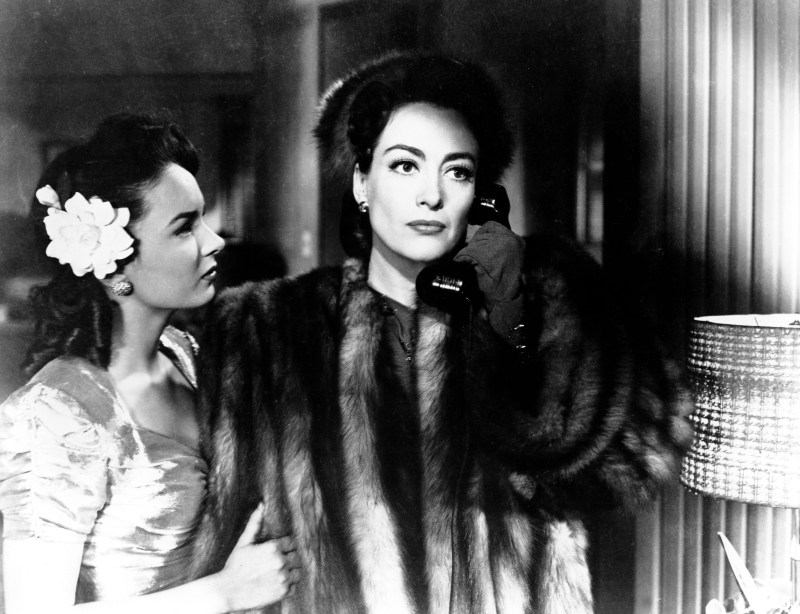Hollywood legend Joan Crawford may have died in 1977, but she’s having a great April. On FX’s new series “Feud,” Jessica Lange stars as Crawford in a pitch-perfect recreation of her rivalry with Bette Davis (played by Susan Sarandon). Our critic Amir Abou-Jaoude recommends Crawford’s 1945 melodrama, “Mildred Pierce,” recently restored and re-released on Blu-Ray and DVD by the Criterion Collection. It is available at the Media and Microtext Center under the call number ZDVD 40569.
Early in Michael Curtiz’s 1945 Best Picture nominee “Mildred Pierce,” the titular character tells her husband, Bert, that her two children “come first in this house, before either one of us. Maybe it’s right, maybe it’s wrong, but that’s the way it is.” She isn’t kidding. “Mildred Pierce,” adapted from James M. Cain’s novel of the same name, documents all the sacrifices Mildred (Joan Crawford) makes for her children. She transforms her two daughters into aristocrats, but ultimately, she finds that they are more attached to money than to their mother. While Michael Curtiz’s skillful direction and Joan Crawford’s commanding portrayal of Mildred elevate this domestic tragedy into a classic film noir, the film’s power derives from its powerful commentary on motherhood and the American dream.
“Mildred Pierce” is a stellar example of film noir, a term used in the 1950s and 1960s by French critics to denote several distinct characteristics present in moody American films of the late 1940s and early 1950s. Most film noirs were B-pictures, cheaply made to fill up the second, less prestigious half of a double feature. These films often dealt with the criminal underbelly of American life. They had a unique look: Most noirs were in black-and-white, but they contained little grey. Instead, chiaroscuro lighting emphasized the sharp contrast between black and white.
Director Michael Curtiz’s striking shots exude film noir style, juxtaposing dark, dim backgrounds with Joan Crawford’s gorgeously lit visage. As Mildred walks on the dank, grimy waterfront in the opening minutes of the film, Curtiz uses these visual hallmarks of film noir to draw us into a dark, illicit world. At the same time, however, he also subverts film noir conventions. Though the film opens with a murder and examines the less seemly side of society, Mildred is no femme fatale. Instead, she is simply a woman struggling to make ends meet in a world dominated by men. After her husband leaves her for another woman, she opens a profitable fast food chain, becomes a business tycoon and eschews the traditional roles of homemaker and wife. Still, her refusal to conform to societal mores makes men perceive her as a dangerous woman, and she is stripped of her maternal attributes.
By focusing on Mildred’s plight, Curtiz fuses the film noir with a commentary on femininity. Curtiz is often overlooked by critics as a director because while he helmed some great films (“Casablanca,”) he also made some terrible ones (“Mission to Moscow.”) But “Mildred Pierce” shows Curtiz at the height of his powers.
Joan Crawford’s Academy-Award winning performance in “Mildred Pierce” is probably the highlight of her career. She had been dubbed “box-office poison” before she made “Mildred Pierce,” and the role was only offered to her after Barbara Stanwyck, Olivia de Havilland, Joan Fontaine and Bette Davis all turned it down. Still, Crawford’s performance is so central to the film that it is difficult to imagine anyone else in the role. She portrays Mildred as a determined, resolute woman, but she never lets us forget the fragility and desperation that undergird each of Mildred’s sacrifices for her daughters.
Crawford’s performance not only enriches the story, but also places the film in the context of a larger discussion about femininity, class, and the American Dream. In some respects, Mildred, a divorcee turned business magnate, seems to personify the American Dream. Still, achieving the American Dream is not enough for Mildred. She longs to consort with people whose wealth is old and inherited. She wants her daughters to be debutantes, to have coming out parties, ostentatious dresses, charming beaus and to enjoy all the things that money can buy.
Yet, Mildred learns that she cannot purchase entrance into high society. She is a magnate, but her money is not inherited. Instead, it is coated with sweat and fast-food grease. As a working woman, she cannot be the subservient spouse husbands prefer. Most tragically, even as she tries to procure them the best of everything, Mildred cannot force her daughters to love her. In reviewing the film in 1945, James Agee wrote that in making all these sacrifices for her daughters, Mildred is “idiotic, or at best pathetic.” I think that Mildred is neither idiotic or pathetic. She is a tragic figure. After giving everything to her daughters, she cannot get anything back. After attaining her goals, she cannot find happiness. She can only stand on the grimy pier in her immaculate fur coat, alone. Ensconced in shadow, she is both the powerful, independent femme fatale and a desperate, vulnerable woman, contemplating her sacrifices and the things that money cannot buy.
Contact Amir Abou-Jaoude at amir2 ‘at’ stanford.edu.
